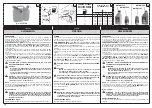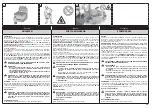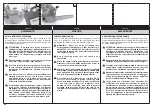
32
English
WORKING WITH TREE SERVICE CHAIN-SAWS FROM A ROPE AND HARNESS
This chapter sets out working practices to reduce the
risk of injury from tree service chainsaws when working
at height from a rope and harness. While it may form
the basis of guidance and training literature, it should
not be regarded as a substitute for formal training.
General requirements working at height
Operators of tree service chainsaws working at height
from a rope and harness should never work alone.
A competent ground worker trained in appropriate
emergency procedures should assist them.
Operators of tree service chainsaws for this work
should be trained in general safe climbing and work
positioning techniques and shall properly equipped
with harnesses, ropes, strops, karabiners and other
equipment for maintaining secure and safe working
positions for both themselves and the saw.
Preparing to use the saw in the tree
The chainsaw should checked, fuelled, started and
warmed up by the ground worker before it is sent up to
the operator in the tree.
The chainsaw should be fitted with a suitable strop for
attaching to the operator’s harness (Fig.1):
a) choke the strop around the attachment point on the
rear of the saw (A, Fig.6);
b) provide suitable karabiners to allow indirect (i.e.
via the strop) and direct attachment (i.e. at the
attachment point on the saw) of saw to the operators
harness;
c) ensure the saw is securely attached when it is being
sent up to the operator;
d) ensure the saw it secured to the harness before it is
disconnected from the means of ascent.
The saw should only be attached to the recommended
attachment points on the harness. These may be at
mid-point (front or rear) or at the sides. Where possible
attaching the saw to centre rear mid-point will keep it
clear of climbing lines and support its weight centrally
down the operator’s spine (Fig.2).
When moving the saw from any attachment point to
another, operators should ensure it is secured in the
new position before releasing it from the previous
attachment point.
Using the chainsaw in the tree
An analysis of accidents with these saws during tree
service operations shows the primary cause as being
inappropriate one-handed use of the saw. In the vast
majority of accidents, operators fail to adopt a secure
work position which allows them to hold both handles of
the saw. This results in an increased risk of injury due to:
- not having a firm grip on the saw if it kicks back;
- a lack of control of the saw such that it is more
liable to contact climbing lines and operators body
(particularly the left hand and arm)
- losing control from insecure work position resulting
in contact with the saw (unexpected movement
during operation of the saw)
Securing the work position for two-handed use
To allow the operator to hold the saw with both hands,
they should as general rule, aim for secure work position
where they are operating the saw at:
- hip level when cutting horizontal sections;
- solar plexus level when cutting vertical sections.
Where the operator is working close into vertical stems
with a low lateral forces on their work position, then a
good footing may be all that is needed to maintain a
secure work position. However as operators move away
from the stem, they will need to take steps to remove or
counteract the increasing lateral forces by, for example,
a re-direct of the main line via a supplementary anchor
point or using an adjustable strop direct from the
harness to a supplementary anchor point (Fig.3).
Gaining a good footing at the working position can be
assisted by use of a temporary foot stirrup created from
an endless sling (Fig.4).
Starting the saw in the tree
When starting the saw in the tree, the operator should:
a) apply the chain brake before starting;
b) hold saw on either the left or right of the body when
starting:
1) on the left side hold the saw with either the left hand
on the front handle or the right hand on the rear
handle and thrust the saw away from the body while
holding the pull starter cord in the other hand;
2) on the right side, hold the saw with the right hand on
either handle and thrust the saw away from the body
while holding the pull starter cord in the left hand.
The chain brake should always be engaged before
lowering a running saw onto its strop.
Operators should always check the saw has sufficient
fuel before undertaking critical cuts.
One-hand use of the chainsaw
Operators should not use tree service chainsaws one-
handed in place of unstable work positioning or in
preference to a handsaw when cutting small diameter
wood at the branch tips.
Tree service chainsaws should only be used one-handed
where:
- the operator cannot gain a work position enabling
two-handed use; and
- they need to support their working position with one
hand; and
- the saw is being used at full stretch, at right angles to
and out of line with the operator’s body (Fig.5).
Operators should never:
- cut with the kickback zone at the tip of the chainsaw
guide bar
- ‘hold and cut’ sections
- attempt to catch falling sections.
Freeing a trapped saw
If the saw should become trapped during cutting,
operators should:
- switch off the saw and attach it securely to the tree
inboard (i.e. towards the trunk side) of the cut or to a
separate tool line;
- pull the saw from the kerf whilst lifting the branch as
necessary;
- if necessary, use a handsaw or second chain saw to
release the trapped saw by cutting a minimum of
30 cm away from the trapped saw.
Whether a handsaw or a chainsaw is used to free a
stuck saw, the release cuts should always be outboard
(toward the tips of the branch), in order to prevent
the saw being taken with the section and further
complicating the situation.
Summary of Contents for 932C
Page 30: ...30 Fig 1 Fig 4 Fig 3 Fig 2 Fig 5 Fig 6 ...
Page 37: ...37 NOTE ...
Page 55: ...55 NOTE ...
Page 64: ...64 NOTE ...
Page 67: ...67 NOTE ...
















































